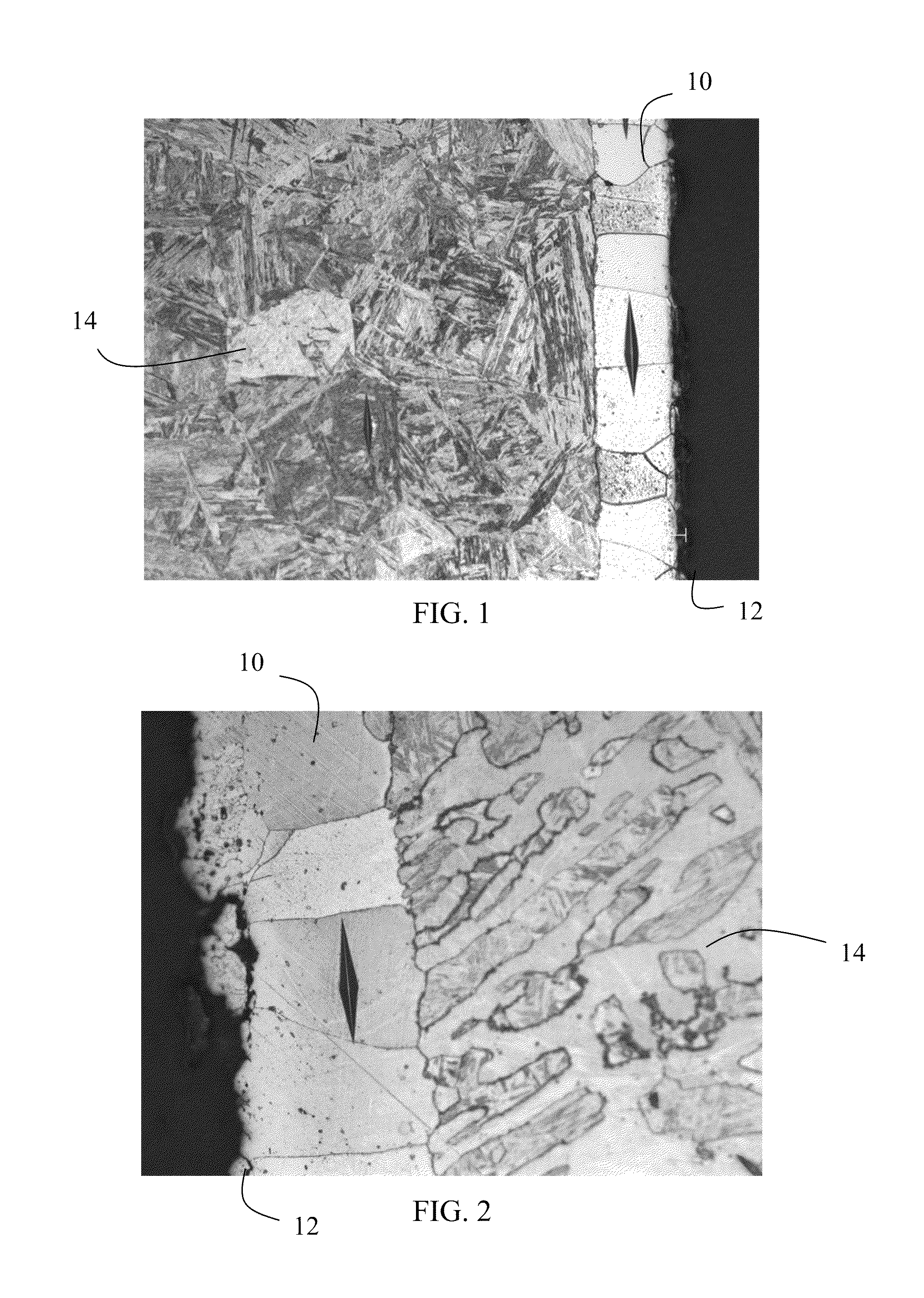Oxidation resistant components and related methods
a technology of oxidation resistance and components, applied in cell components, final product manufacturing, sustainable manufacturing/processing, etc., can solve the problems of chromium poisoning or contamination within, degradation of fuel cells, and problems such as chromium contamination, and achieve the effect of reducing chromium contamination
- Summary
- Abstract
- Description
- Claims
- Application Information
AI Technical Summary
Benefits of technology
Problems solved by technology
Method used
Image
Examples
example 1
[0036]A slurry coating composition was prepared having the following slurry composition, by weight: 50% chromium aluminum (56Cr-44Al), 10% ammonium chloride, the balance being VITTA BRAZ-BINDER GEL. The chromium aluminum was in powder form having a particle size of −200 mesh.
[0037]Ten test pieces were also prepared from a forged Cr—Mo—V—Nb—B alloy steel (9.0-9.6% Cr, 1.50-1.70% Mo, 0.25-0.30% V, 0.045-0.065% Nb, 0.008-0.012% B). The test pieces each had an approximate size of 25.4×25.4×12.7 mm (1×1×0.5 inches). A slurry coating of non-uniform thickness was applied directly to the surface of each of the test pieces. The coating was applied by pouring the slurry mixture over the test pieces and spreading the mixture around the entire surface of each test piece.
[0038]The test pieces were placed in a retort, which was then purged with argon until a −40° F. dew point was achieved. The temperature within the retort was then heated to the diffusion temperature indicated in Table 1 (i.e., 1...
example 2
[0041]A slurry coating composition was prepared having the following slurry composition, by weight: the percentage of chromium aluminum (56Cr-44Al) indicated in Table 2, 10% ammonium chloride, the balance being VITTA BRAZ-BINDER GEL. The chromium aluminum was in powder form having a particle size of −200 mesh.
[0042]Four test pieces were prepared from a forged Cr—Mo—V—Nb—B alloy steel (9.0-9.6% Cr, 1.50-1.70% Mo, 0.25-0.30% V, 0.045-0.065% Nb, 0.008-0.012% B). The test pieces each had an approximate size of 25.4×25.4×12.7 mm (1×1×0.5 inches). A slurry coating of non-uniform thickness was applied directly to the surface of each of the test pieces. The coating was applied by pouring the slurry mixture over the test pieces and spreading the mixture around the entire surface of each test piece.
[0043]The test pieces were placed in a retort, which was then purged with argon until a −40° F. dew point was achieved. The temperature within the retort was then heated to a diffusion temperature ...
example 3
[0045]A slurry coating composition was prepared having the following slurry composition, by weight: 50% chromium aluminum (56Cr-44Al), 10% ammonium chloride, the balance being VITTA BRAZ-BINDER GEL. The chromium aluminum was in powder form having a particle size of −200 mesh.
[0046]A test piece was prepared from a cast 410 stainless steel (12% Cr). The test piece had an approximate size of 25.4×25.4×12.7 mm (1×1×0.5 inches). A slurry coating of non-uniform thickness was applied directly to the as-cast surface of the test piece. The coating was applied by pouring the slurry mixture over the test piece and spreading the mixture around the entire surface of the test piece.
[0047]The test piece was placed in a retort, which was then purged with argon until a −40° F. dew point was achieved. The temperature within the retort was then heated to a diffusion temperature of 2000° F. and held at such temperature for a duration of 4 hours. The argon gas flow was maintained during heating. The ret...
PUM
| Property | Measurement | Unit |
|---|---|---|
| Temperature | aaaaa | aaaaa |
| Length | aaaaa | aaaaa |
| Fraction | aaaaa | aaaaa |
Abstract
Description
Claims
Application Information
 Login to View More
Login to View More - R&D
- Intellectual Property
- Life Sciences
- Materials
- Tech Scout
- Unparalleled Data Quality
- Higher Quality Content
- 60% Fewer Hallucinations
Browse by: Latest US Patents, China's latest patents, Technical Efficacy Thesaurus, Application Domain, Technology Topic, Popular Technical Reports.
© 2025 PatSnap. All rights reserved.Legal|Privacy policy|Modern Slavery Act Transparency Statement|Sitemap|About US| Contact US: help@patsnap.com

